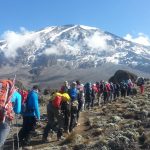Oxygen tank on Kilimanjaro

Oxygen tank on Kilimanjaro, as we go higher and higher, at high altitudes, amount of oxygen present in the atmosphere is determined by atmospheric pressure. Though the concentration of oxygen is 21% and is constant throughout the air, the layer of air at heights above than 12000 feet becomes thinner and thinner. This decreases the number of oxygen molecules per breath making the person suffocated at high altitudes.
As we go higher and higher the pressure and the oxygen decrease so as due to less oxygen content they carry oxygen cylinders
91% of the companies on Kilimanjaro do NOT offer supplementary oxygen – because it is potentially dangerous, wholly unnecessary and against the spirit of climbing Kilimanjaro. The challenge of the mountain lies within the fact that the summit is at a high elevation, where climbers must adapt to lower oxygen levels at altitude, we do much safety.
Oxygen and us: the truth. Oxygen tank on Kilimanjaro
This can, of course, be seriously detrimental to your health; oxygen is, after all, pretty essential to your physical well-being. All of your vital organs need it, as do your muscles. They receive their oxygen via red blood cells, which are loaded with oxygen by your lungs and then pumped around your body by your heart, delivering oxygen as they go. Problems arise at altitude when that most vital of organs, the brain, isn’t getting enough oxygen and malfunctions as a result; because as the body’s central control room, if the brain malfunctions, so does the rest of you, often with fatal consequences.
So how does a lack of oxygen lead to altitude sickness?
Fortunately, your body is an adaptable piece of machinery and can adjust to the lower levels of oxygen that you breathe in at altitude. Unconsciously you will start to breathe deeper and faster, your blood will thicken as your body produces more red blood cells, and your heart will beat faster. As a result, your essential organs will receive the same level of oxygen as they always did.
But your body needs time before it can affect all these changes. Though the deeper, faster breathing and heart-quickening happen almost as soon as your body realizes that there is less oxygen available, it takes a few days for the blood to thicken. And with Kilimanjaro, of course, a few days is usually all you have on the mountain, and the changes may simply not happen in time. The result is AMS.
AMS, or acute mountain sickness (also known as altitude sickness), is what happens when the body fails to adapt in time to the lack of air pressure at altitude. There are three levels of AMS: mild altitude sickness, moderate altitude sickness and severe altitude sickness. On Kilimanjaro, it’s fair to say that most people will get some symptoms of the illness and will fall into the mild-to-moderate categories.
Having symptoms of mild AMS is not necessarily a sign that the sufferer should give up climbing Kilimanjaro and descend immediately. Indeed, most or all of the symptoms suffered by those with mild AMS will disappear if the person rests and ascends no further, and assuming the recovery is complete, the assault on the summit can continue.
The same goes for moderate AMS too, though here the poor individual and his or her symptoms should be monitored far more closely to ensure that they are not getting any worse and developing into severe AMS. This is a lot more serious and sufferers with severe AMS should always descend immediately, even if it means going down by torchlight in the middle of the night.








